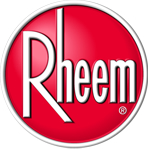Air conditioner not cooling
To diagnose or correct air conditioning problems such as reduced air conditioner cooling capacity or a system that simply won't start takes training and experience. However, we have listed some common troubleshooting that a homeowner could inspect before calling for service.
- Check thermostat: batteries, programmable settings.
- Reset breakers: as they may be interrupted.
- Check for water damage in the air handler. A blockage in the condensate drain is going to lead leaks out of the air handler into the overflow pan. it is important to keep condensation lines clean as this will prevent bacterial growth blockage. The overflow pan itself should have a separate auxillary drain line, should this line be clogged then it will overflow onto the ceilings creating some costly damage, including a possible mold problem.
- Replace dirty filters. Dirty filters can lead to lost cooling capacity first as it reduces the air flow through the system.
- Condenser fan running but not cooling. Older air conditioner compressor motor may be unable to properly compress the returning refrigerant gas to a sufficiently high pressure or it may be low on freon. Have a Penguin air conditioning service technician take an evaluation and test the system.
- Condenser will not start and is making clicking sounds. This could lead to an electrical malfunction possibly the capacitor, contactor or both. Have a Penguin air conditioning service technician take an evaluation and test the system.
- Refrigerant lines frozen ice build-up on the air conditioner air handler or evaporator coil, A common problem is reduced air flow due to a dirty air conditioning filter can cause the evaporator coil in the air handler to become blocked by ice, stopping or significantly reducing cool air output from the system. However if filters look good have a Penguin air conditioning service technician take an evaluation and test the system.
Not sure if you should repair or replace?
Even if your older system still seems to be running smoothly, you might consider investing in a new model, especially if your system is more than 10 years old. That’s because a higher-efficiency system can significantly reduce your energy bills. As an added benefit, it can enhance the comfort and quality of your home’s air, above all this you're doing your part to protect the environment. The less energy your system uses the lower demands on power plants, which means less pollution. Innovations like the new, U.S. EPA-approved R410A refrigerant can also benefit the global environment.
The U.S. Environmental Protection Agency offers a similar to the following checklist to help you decide whether you should replace your current system or invest in a new one.
You may want to consider making a change if:
❏ Some of your rooms are too hot or cold.
Duct problems, inadequate air sealing or insulation could be the cause. No matter how efficient your
heating and cooling system is, if your home is not properly sealed and insulated against air leakage, you
will not be as comfortable and your system will have to work harder.
❏ Your home has humidity problems and/or excessive dust.
Poorly operating or improperly sized equipment could be to blame. Leaky ductwork can also cause these
problems, so having it sealed may be a solution. Monthly maintenance of your heating and cooling
equipment’s filters may also help.
❏ Your cooling system is noisy.
Your duct system could be improperly sized or there may be a problem with the indoor coil of your
cooling equipment.
❏ Your equipment needs frequent repairs and your energy bills are going up.
In addition to the rise in energy costs, the age and condition of your heating and cooling equipment may
have caused it to become less efficient.
❏ Your air conditioner or heat pump is more than 12 years old.
Consider replacing it with newer, more efficient equipment. And, remember, high efficiency levels begin
with ENERGY STAR.
❏ Your furnace or boiler is more than 15 years old.
Consider replacing it with ENERGY STAR® qualified equipment. ENERGY STAR has set high efficiency
guidelines for both types of heating systems.
❏ You leave your thermostat set at one constant temperature.
You could be missing a great energy-saving opportunity. A programmable thermostat adjusts your home’s
temperature at times when you’re regularly away or sleeping.
❏ Your score on the ENERGY STAR Home Energy Yardstick is below five.
That means you’re using more energy at home than most Americans and probably paying more than you
need to on energy bills. Get personalized recommendations to improve your home and/or heating and
cooling system. Find the Home Energy Yardstick at www.energystar.gov Click on Home Energy Analysis.
Source: “A Guide to Energy-Efficient Heating and Cooling,” U.S. Environmental Protection Agency










